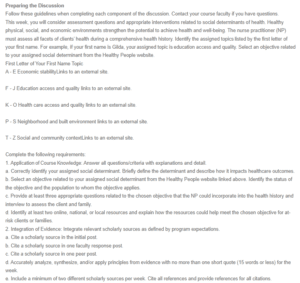Question Preparing the Discussion Follow these guidelines when completing each component of the discussion. Contact your course faculty if you have questions. This week, you will consider assessment questions and appropriate interventions related to social determinants of health. Healthy physical, social, and economic environments strengthen the potential to achieve health and well-being. The nurse practitioner (NP) must assess all facets of clients’ health during a comprehensive health history. Identify the assigned topics listed by the first letter of your first name. For example, if your first name is Gilda, your assigned topic is education access and quality. Select an objective related to your assigned social determinant from the Healthy People website. Neighbourhood and Built Environment First Letter of Your First Name Topic A – E Economic stabilityLinks to an external site. F – J Education access and quality links to an external site. K – O Health care access and qualit
Neighbourhood and Built Environment
My assigned social determinant is Neighborhood and Built Environment, which refers to the physical and social aspects of the surroundings where individuals live, work, and play. The neighbourhood and built environment impact healthcare outcomes by influencing individual health behaviours and access to healthcare services (Burse et al., 2022). Additionally, the built environment can impact individual health behaviours, such as physical activity levels and access to healthy food options.
As part of the Healthy People 2030 project, which seeks to enhance the health and wellbeing of people and communities in the United States, the goal of “Increasing the proportion of schools with policies and practices that promote health and safety” has been set. The status of this objective is “Developmental,” indicating that it is still being developed for the next iteration of Healthy People. This goal might enhance the health and wellbeing of students and faculty, minimize health inequities, and foster academic performance by increasing the number of schools with health and safety-promoting policies and practices.
Here are three questions the NP could ask the client and family during the health history and interview to gauge their overall health:
- Are you aware of any health policies or practices in your child’s school that promote physical activity or healthy eating?
- Has your child ever experienced bullying or harassment at school?
- Does your child’s school offer any resources or programs to support students’ mental health and wellbeing?
Nurse practitioners (NPs) can use online, national, and local resources to increase the proportion of schools with policies and practices that promote health and safety. A web-based tool from the Centers for Disease Control and Prevention (CDC) called the School Health Index can be used by schools to evaluate current health policies and practices, pinpoint areas for improvement, and create action plans (Kokko & Baybutt, 2022). Local health departments can provide technical assistance, resources, and programs to support school health, such as nutrition education, physical activity programs, and mental health services (O’Toole et al., 2022). By referring schools and families to these resources, NPs can help create safe and healthy school environments for their clients and their families and promote their overall health and wellbeing.
References
Burse, N. R., Weng, X., Wang, L., Cuffee, Y. L., & Veldheer, S. (2022). Influence of social and behavioral determinants on health-related quality of life among cancer survivors in the USA. Supportive Care in Cancer, 31(1). https://doi.org/10.1007/s00520-022-07534-0
Kokko, S., & Baybutt, M. (2022). Handbook of Settings-Based Health Promotion. In Google Books. Springer Nature. https://books.google.com/books?hl=en&lr=&id=40NuEAAAQBAJ&oi=fnd&pg=PA105&dq=The+Centers+for+Disease+Control+and+Prevention+(CDC)+School+Health+Index+is+an+online+tool+that+can+help+schools+assess+their+health+policies+and+practices
O’Toole, T. P., Blanck, H. M., Flores-Ayala, R., Rose, K., Galuska, D. A., Gunn, J., O’Connor, A., Petersen, R., & Hacker, K. (2022). Five Priority Public Health Actions to Reduce Chronic Disease Through Improved Nutrition and Physical Activity. Health Promotion Practice, 23(1_suppl), 5S11S. https://doi.org/10.1177/15248399221120507
